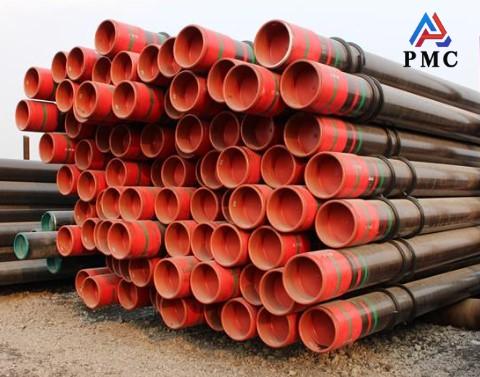
OCTG Casing Pipe
What is OCTG casing pipe?
OCTG (Oil Country Tubular Goods) includes a range of tubular products used in oil and gas wells. Among them, OCTG casing pipe is a steel pipe inserted from the surface into a drilled wellbore to line and support the wellbore walls. In complex underground geology, where formation pressure rises with depth, an unsupported wellbore can collapse, causing drilling interruptions, equipment damage, and safety risks. By working together with OCTG drill pipe and seamless pipe, casing pipe provides reliable support, maintains well integrity, and ensures safe and efficient oil and gas production.
The basic structure of OCTG casing pipe
OCTG casing pipe generally consists of a pipe body and couplings. The pipe body is the main component of the casing pipe, and its diameter and wall thickness are key parameters. The diameter determines the casing pipe’s flow path, which in turn affects its oil and gas transport capacity. For example, in some high-yield oil and gas wells, larger diameter casing pipe is required to ensure rapid oil and gas transport. Wall thickness directly affects the casing pipe's strength and pressure resistance. In deep drilling, due to the high formation pressure, thicker wall casing pipe is required to ensure wellbore stability.
Types of OCTG casing pipe
Common OCTG casing pipe types include surface casing pipe , technical casing pipe, and production casing pipe.
Surface casing pipe: mainly used to isolate shallow surface water layers and shallow loose and complex layers, provide support for wellhead equipment and prevent shallow fluid contamination. It is usually shallow and bears relatively small pressure. The main specifications are 508mm (20in), etc., and K55 steel grade or N80 steel grade is mostly used. For example, in general onshore oil field exploitation, surface casing pipe can protect the strata near the wellhead and ensure the safety of subsequent drilling operations.
Technical casing pipe: used to isolate complex formations, such as collapsed layers, oil layers, gas layers, water layers, etc., to prevent wellbore collapse and provide a solid foundation for subsequent production tubing. It needs to withstand higher pressure and temperature conditions, and has high requirements for mechanical properties and sealing performance. It also uses a variety of steel grades. In addition to K55, N80 and P110 steel grades are more commonly used. The main specifications include (13-3/8in) and so on. In some areas with complex geological conditions, technical casing pipe is like a solid barrier, ensuring the smooth progress of drilling work.
Production casing pipe: This is the final layer of casing pipe installed after drilling reaches the target formation. It protects the producing stratum and provides a pathway for oil and gas production. It reaches the deepest depths of all casing pipes types and has the highest requirements for mechanical and sealing properties. Steel grades include K55, N80, and P110, and sizes include 7-inch. Like a "highway" for oil and gas to reach the surface, production casing pipe plays a crucial role in the smooth extraction of oil and gas.

OCTG casing pipe core performance characteristics
1. High Strength and Load Resistance: Acting as the wellbore’s “support framework,” OCTG casing pipe must withstand underground loads such as formation pressure, drilling fluid pressure, and production-related dynamic impacts. Crafted from high-strength carbon/alloy steel (e.g., API 5CT J55, N80, P110) with 415-862 MPa tensile strength, it fends off radial pressure from increasing well depth to prevent deformation or breakage.
2. Excellent Corrosion Resistance: Underground, formation water, H₂S, and CO₂ easily cause corrosion. OCTG casing pipe resists acidic and electrochemical corrosion via material optimization (e.g., 13Cr stainless steel, corrosion-resistant alloy casings) or surface treatments (e.g., phosphating, coating), cutting sulfide stress cracking risks and extending service life—especially in high-sulfur oil and gas fields.
3. Excellent Toughness & Fatigue Resistance: Casing pipe faces alternating loads like vibration and temperature fluctuations during drilling and production, needing good toughness. Via controlled rolling/cooling and quenching-tempering, its low-temperature impact toughness (≥27J at -40°C) meets standards, avoiding brittle fracture in low-temperature or impact scenarios. It also has strong fatigue resistance, endure long-term cyclic loads without failure.
4. High-Precision Sealing: Casing pipes are threaded to form a sealed string that isolates fluids between formations. Their high-precision threads (e.g., API round threads, trapezoidal threads, special sealing buckles) paired with sealing grease or metal seals ensure strong airtightness under high pressure, stopping oil/gas leakage and formation water intrusion for safe mining.
OCTG casing pipe main application areas
1. OCTG casing pipe is used for oil and gas production, with onshore oil and gas fields being the main scenario. It is suitable for both conventional and unconventional wells, relying on multi-layer casing to support the well wall and isolate the strata. It is also used on offshore platforms and subsea wells, and is resistant to corrosion and impact. It is also suitable for special working conditions such as high sulfur content, low temperature, and ultra-deep wells to ensure mining safety.
2. OCTG casing pipe is primarily used in oil and gas development: onshore oil and gas fields use it to support well walls and isolate formations, suitable for both conventional and unconventional wells; offshore platforms and subsea wells require it to be corrosion-resistant and impact-resistant; and special working conditions such as high sulfur content, low temperatures, and ultra-deep wells also rely on it to ensure stable mining.
Read more: What are the Grades of OCTG Casing Material?
- 【Prev】 : Standard for SMLS Pipes for Fluids
- 【Next】 : OCTG Drill Pipe


